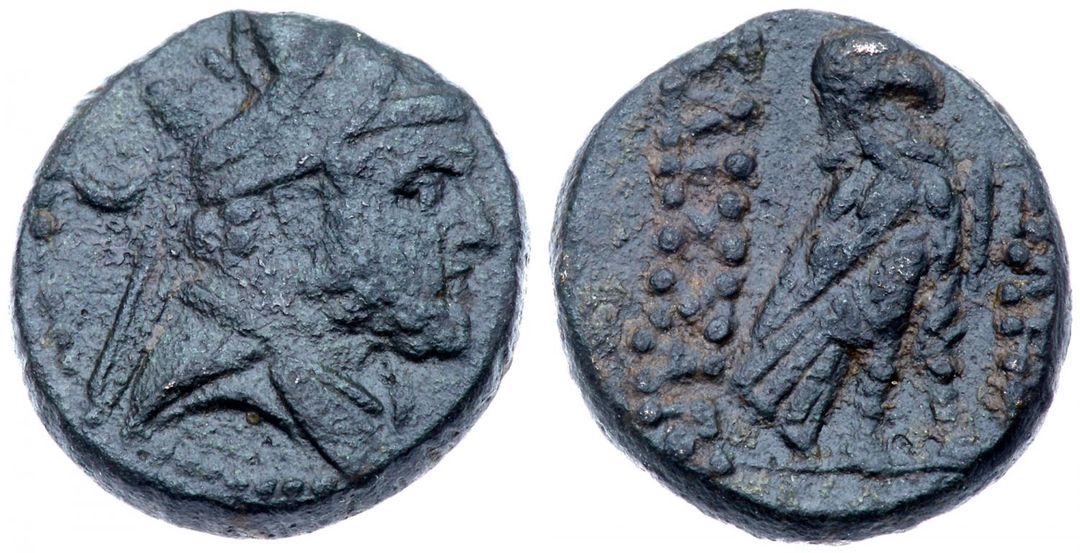Abdissares - AE 2 chalkoi - Eagle
Identifier
Kovacs-13; ACV-16; Alram-175; ANRO-512
Reference Description
Abdissares c.3rd-2nd cent. BC
AE 2 chalkoi
Obv. Head of Abdissares right, lightly bearded, wearing folded tiara; diademed with ribbon hanging behind head. Border of dots.
Rev. ΒΑΣΙΛΕΩΣ ΑΒΔΙΣΣΑΡΟΥ
Eagle standing right.
AE 2 chalkoi
Obv. Head of Abdissares right, lightly bearded, wearing folded tiara; diademed with ribbon hanging behind head. Border of dots.
Rev. ΒΑΣΙΛΕΩΣ ΑΒΔΙΣΣΑΡΟΥ
Eagle standing right.
Recent Sales
| Auction | Date | Characteristics | Realized | |
| 2 | Leu 5 Lot 171 | 26-Oct-2019 | 14mm, 3.25g, 12h | CHF 1,300 |
| 1 | Goldberg 106 Lot 1095 | 2-Sep-2018 | 3.60g? | $900 |
Notes
Leu 5 Lot 171
Abdissares' coinage is very similar to that of Xerxes (Kovacs 17-20) and of the 'Unknown King I', whose name Kovacs suggested to read as [Art]abanos (Kovacs 21). The clear stylistic and iconographic connections group those three kings together, but historiographical evidence is scanty: Polybios refers to Xerxes as a 'King of Arsamosata' (Pol. 8.23), who subjected to the Seleukid King Antiochos III 'the Great' in 212 BC, whereas in the cases of Artabanos (?) and Abdissares, no literary or epigraphic evidence has survived. Fortunately, the extremely rare coinage of Abdissares provides some clues, as three of his issues include the geographical reference AΔIABHNOY to his titulature - an unprecedented and unparalleled phenomenon in the coinage of the Hellenistic East. If we accept Abdissares at his word, he thus must have been King of Adiabene. This fits well with the name Abdissares, which appears to be an Aramaic form of the Neo-Babylonian 'Ab-di-Iš-šár', translating as 'servant of Issarbel', i.e. 'servant of the Ištar of Arbela'. Arbela was an old city in Adiabene with a venerable cult of Ištar going back to the Assyrians: it might have served as one of the cultural and political centers of Abdissares' Kingdom. Grabowski has recently argued for an identification of the unknown King on the Batas-Herir Relief near Arbela with Abdissares, and while this tempting suggestion has not remained unchallenged, his remarks about the eagle on Abdissares coins are of great importance regarding the dating of the King's reign. Grabowski noted that the use of an eagle standing to the right with closed wings as Abdissares' main reverse type clearly differentiates his coinage from that of Xerxes and Artabanos (?), and he draws an iconographical connection to the prominent display of a similar eagle on the coinage of the Seleukid King Antiochos IV following his campaigns against Ptolemaic Egypt in 170-168. If this connection is true, it places Abdissares to the 160s BC at the earliest, more specifically perhaps to after 164, when Antiochos IV died and many of the Seleukid provinces in the East were thrown into turmoil. Abdissares may then have been a descendant of Xerxes and Artabanos (?), whose Royal imagery he adopted after revolting against the Seleukids while changing their traditional early Hellenistic reverse types (Nike and Athena) to a more current design.
Abdissares' coinage is very similar to that of Xerxes (Kovacs 17-20) and of the 'Unknown King I', whose name Kovacs suggested to read as [Art]abanos (Kovacs 21). The clear stylistic and iconographic connections group those three kings together, but historiographical evidence is scanty: Polybios refers to Xerxes as a 'King of Arsamosata' (Pol. 8.23), who subjected to the Seleukid King Antiochos III 'the Great' in 212 BC, whereas in the cases of Artabanos (?) and Abdissares, no literary or epigraphic evidence has survived. Fortunately, the extremely rare coinage of Abdissares provides some clues, as three of his issues include the geographical reference AΔIABHNOY to his titulature - an unprecedented and unparalleled phenomenon in the coinage of the Hellenistic East. If we accept Abdissares at his word, he thus must have been King of Adiabene. This fits well with the name Abdissares, which appears to be an Aramaic form of the Neo-Babylonian 'Ab-di-Iš-šár', translating as 'servant of Issarbel', i.e. 'servant of the Ištar of Arbela'. Arbela was an old city in Adiabene with a venerable cult of Ištar going back to the Assyrians: it might have served as one of the cultural and political centers of Abdissares' Kingdom. Grabowski has recently argued for an identification of the unknown King on the Batas-Herir Relief near Arbela with Abdissares, and while this tempting suggestion has not remained unchallenged, his remarks about the eagle on Abdissares coins are of great importance regarding the dating of the King's reign. Grabowski noted that the use of an eagle standing to the right with closed wings as Abdissares' main reverse type clearly differentiates his coinage from that of Xerxes and Artabanos (?), and he draws an iconographical connection to the prominent display of a similar eagle on the coinage of the Seleukid King Antiochos IV following his campaigns against Ptolemaic Egypt in 170-168. If this connection is true, it places Abdissares to the 160s BC at the earliest, more specifically perhaps to after 164, when Antiochos IV died and many of the Seleukid provinces in the East were thrown into turmoil. Abdissares may then have been a descendant of Xerxes and Artabanos (?), whose Royal imagery he adopted after revolting against the Seleukids while changing their traditional early Hellenistic reverse types (Nike and Athena) to a more current design.
Collection
Citation
“Abdissares - AE 2 chalkoi - Eagle,” Armenian Numismatic Research Organization, accessed January 22, 2025, https://armnumres.org/items/show/512.



